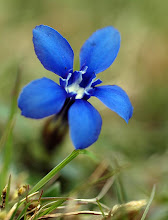Almost as soon as plants colonised the land surface they began to compete for light, struggling to grow out of each other’s mutual shade. The ultimate solution, adopted by trees, was to produce woody stems and grow tall, shading out competitors below. It's a very successful strategy - left to their own devices, many terrestrial ecosystems where water and warmth are adequate become forests. These (above) are cross sections of stems of two sycamore Acer pseudoplatanus seedlings, just a couple of weeks after germinating from a seed in spring, and already they have begun to produce woody thickening in some of their cells, visible here as the bright yellow fluorescent staining inside the stem (on the periphery of the large pith cells in its core). The very narrow yellow fluorescent line around the perimeter of the stem is the waxy cuticle secreted by the epidermal cells that protects the young stem – just a couple of millimetres in diameter at this stage - from water loss and invasion by pathogens. Double-click on the image for a clearer picture.
Fast-forward almost three years now and this seedling has grown into a sapling. In this cross section of a three year old lime (Tilia sp.) stem the big cells at the core are the pith. The three concentric rings of brown cells outside of that contain the xylem vessels that conduct water up and down the stem. They’re dead and their walls are strengthened with woody lignin, producing a strong, rigid support for the fast growing shoot and leaves. The width of those annual rings varies according the growing season – but I suspect that the outer, most recent ring is narrower because this shoot was harvested for microscopic sectioning sometime in mid-summer, before that year's annual growth was complete. Take a close look at the outer edge of the outer annual ring of xylem (double click the image to enlarge) and you may just be able to make out a distinct narrow zone of very small blue-stained cells, just a few cells thick (at about 7 o'clock on the section). This is the cambium – the thin layer of living cells that divides to produce dead xylem cells on its inner face and living phloem cells, that conduct sugars from the leaves to the rest of the plant, on the outer side. Together the phloem and cambium are only a few cells thick and represent the most important living tissue inside the tree. Their protection is vital for the tree’s survival, so they are covered by a thick layer of bark tissue, also stained blue where the cells are alive but showing as grey-brown on the outer surface of the twig, where they are dying or dead. This is the tree’s waterproof, self-repairing, insulating, wound healing tissue, protecting the delicate living layer of cells inside. Growing tall by producing annual rings of growth is a long-term investment for a plant which only reaches full size after decade of growth, but the return on investment can then continue over centuries – and in some cases millennia - of annual flowering and seed production. As the stem adds annual rings, expanding in girth with every succeeding year, the outer dead bark layer splits into characteristic patterns, depending on the tree species. The line of red cells in the bark tissues are fibres - dead cells that strengthen the young stem.
















A great clear illustrated explanation Phil.
ReplyDeleteThis sections of plant stems reveal fascinating patterns, don't they John?
ReplyDeleteI dont have any words to explain this. I wish I had seen this when I was a science student.
ReplyDeleteStunning images.
ReplyDeleteSurely there is a God.
The sapling cross-section is gorgeous! Do you sell your photographs? I'd love this one on my wall!
ReplyDeleteI don't sell prints Katherine but you are welcome to download the image and use it as a screen saver. Thanks for visiting!
Delete